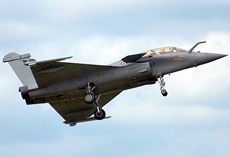India is still world’s largest arms importer
18 Mar 2014
India continued to be the world's largest arms importer in 2013, with armament imports that are three times larger than those of China and Pakistan – the second and third-largest importers, the Swedish think-tank Stockholm International Peace Research Institute (SIPRI) found.
 Although it might not be the study's intention, it throws a damning sidelight on India's state-controlled armament manufacture and indigenisation efforts, which have made little headway over decades of efforts. China has much larger and better equipped armed forces, yet its imports are a third of India's.
Although it might not be the study's intention, it throws a damning sidelight on India's state-controlled armament manufacture and indigenisation efforts, which have made little headway over decades of efforts. China has much larger and better equipped armed forces, yet its imports are a third of India's.
"The volume of Indian imports of major weapons rose by 111 per cent between 2004-2008 and 2009-13, and its share of the volume of international arms imports increased from 7 to 14 per cent. Meanwhile, Pakistan's imports of major arms increased by 119 per cent," the think tank said.
Pakistan has always got almost all its defence equipment from abroad – a cause of envy to Indian troops fighting their inimical neighbour in high mountain warfare on the Siachen glacier and elsewhere. While the Indians have to use bulky and unwieldy 'home-made' clothing and tents, the Pakistanis have fancy for US-made stuff.
The SIPRI data said that Russia was the major supplier of arms to India in 2009-13, accounting for 75 per cent of imports. The United States for the first time became the second largest arms supplier to India, with a 7 per cent share, overtaking Israel in this regard.
"In contrast, the USA's share of Pakistan's imports in the same period was 27 per cent. China was also a major supplier in the region, accounting for 54 per cent of Pakistani arms imports and 82 per cent of Bangladeshi imports," the report said.
Commenting on the arms supply business in the South Asian region, the SIPRI report said the US and China "appear to be using arms deliveries to Asia to strengthen their influence in the region".
In its report on world arms transfers, SIPRI said that South Asia, including both India and Pakistan, and the Arabian Gulf states led by Saudi Arabia and the United Arab Emirates (UAE) have shown a rising trend in arms imports.
SIPRI pointed out that "its data reflects the volume of deliveries of arms, not the financial value of the deals. As the volume of deliveries can fluctuate significantly year-on-year, SIPRI presents data for 5-year periods, giving a more stable measure of trends."
It has to be kept in mind that although India has acquired substantial number of weapons, these do not indicate any aggressive build-up, as most of what is being bought is to replace its 30 to 40-year-old inventory, the report says.
Further, there are several important deals pending either due to procedural delays or allegations of corruption, necessitating inquiries.
Sources in India's defence ministry told India Strategic defence magazine that the SIPRI report is "interesting, but not surprising," adding that several major systems had been ordered in the recent years for all the three Services.
"There are delays, yes, largely due to correct or unfounded allegations, and also due to procedural issues both within the armed forces and the MoD, but there has been progress forward," the sources said.
The Indian Air Force (IAF), for instance, has selected several systems from combat aircraft (Rafale MMRCA) to midair refuellers (Airbus A 330 MRTT), Boeing C-17 Globemaster III heavy lift transport aircraft, Lockheed Martin's C-130J Special Operations aircraft, Russian Mi 17 V5 helicopters, 272 SU-30 MKI combat aircraft, and other deals.
Agreements have also been reached with Russia for co-production of Multirole Transport Aircraft (MTA) and the Fifth Generation Multirole Perspective Aircraft (initially called Fifth Generation Fighter Aircraft) besides acquisition of a large number of tanks and armour.
Israel so far had a major share in Indian imports due to the three Phalcon AWACS (Airborne Warning and Control Systems) aircraft, or 'eyes in the sky'.
Some deals, like those for Boeing's C-47 Chinook and AH 64D Apache helicopters, and BAE Systems lightweight M777 howitzers, are still pending, with a government hampered from taking major decisions before the elections in less than a month.













.jpg)






.jpg)









